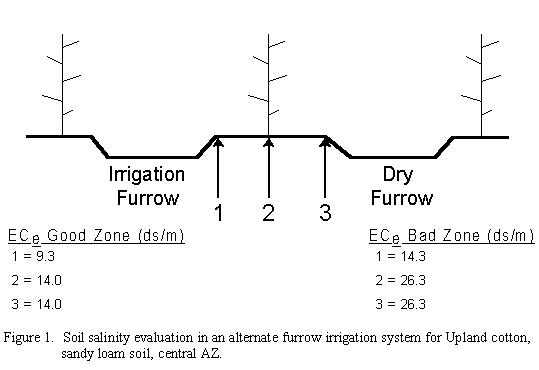Saline and Sodic Soil Identification and Management for Cotton
(Publication az1199)
(PDF file version, 34KB)
by Jeffrey C. Silvertooth,
Extension Agronomist - Cotton
Soil salinity and sodicity are natural components of desert agricultural systems and have plagued many attempts at developing and maintaining crop production systems in arid regions. The first step in developing appropriate management schemes for dealing with saline and or sodic soil conditions involves proper identification (Table 1). By definition a saline soil is a nonsodic soil containing sufficient soluble salt to adversely affect the growth of most crop plants with a lower limit of electrical conductivity of the saturated extract (ECe) being 4 deciSiemens / meter (dS/m), which is equivalent to a value of 4 mmhos/cm. It is important to note that this is a lower limit and soil salinity conditions are actually dependent upon the crop in question. For example, cotton is considered to be relatively salt tolerant (Table 2) in relation to many other common crop plants.
It is also important to point out that cotton seedlings are sensitive to soil salinity with ECe levels of 4 dS/m or more. However, cotton seedlings in Arizona have been found to survive and grow in very saline conditions. Figure 1 describes the soil salinity conditions found in a cotton field in central Arizona that was experiencing stand and establishment problems. Therefore, soil samples and ECe measurements were taken at a two inch depth from three positions on the bed in relation to the irrigation furrow and the seed line, for each of the “good” (with healthy seedlings) and “dead” zones in the field. This demonstrates the ranges of soil salinity that cotton can tolerate before absolutely killing the plant. However, vigor and yield potentials are compromised at lower salinity levels before plants cannot survive due to salinity. This also illustrates the value of using alternate row irrigation in terms of “pushing” the higher concentrations of salt away from the water furrow toward the dry furrow (positions 1, 2, and 3 in Figure 1). Therefore, it is also important to push the salts past the seed line.
A sodic soil is defined as a nonsaline soil containing sufficient exchangeable sodium (Na) to adversely affect crop production and soil structure under most conditions of soil and plant type. The sodium adsorption ratio of the saturation extract (SARe) is at least 13. Fine textured soils (i.e. clays, clay loams, silts, silt loams, etc.) may experience dispersion and crusting due to Na with SAR levels of 5 or 6.

Management for a saline soil involves “leaching” the soluble salts from the soil profile. Leaching requires the application of irrigation water at rates above and beyond the basic water needs of the crop. Leaching takes place with the percolation of soil solutes (soluble salts) under saturated soil conditions. Management for sodic soils generally requires a two step process: 1. replacing exchangeable Na with a more favorable ion such as calcium (Ca) and/or magnesium (Mg); and 2. leaching the soluble Na that has been replaced on the soil colloid by the application of excess irrigation water. Therefore, saline soils do not require ammendments per se. Sodic soils may require the application of soil ammendments, such as gypsum (CaSO4) as a Ca source. Management of either condition requires proper identification of soil conditions in addition to good management of the irrigation water applied to the field in question.
The quality of the irrigation water being used is often a primary source of the soluble salts being applied to the field. Irrigation waters with ECw values of 0.7 to 3.0 dS/m may pose slight restrictions in use, with severe limitations being associated with waters having ECw values > 3.0 dS/m.
 |
Issued in furtherance of Cooperative Extension work, acts of May 8 and June 30, 1914, in cooperation with the U.S. Department of Agriculture, James A. Christenson, Director Cooperative Extension, College of Agriculture and Life Sciences, The University of Arizona.
The University of Arizona is an equal opportunity, affirmative action institution. The University does not discriminate on the basis of race, color, religion, sex, national origin, age, disability, veteran status, or sexual orientation in its programs and activities.
Any products, services, or organizations that are
mentioned, shown, or indirectly implied in this web document do not imply
endorsement by The University of Arizona.
Information provided by Jeffrey C. Silvertooth, silver@ag.arizona.edu
Extension Agronomist - Cotton, College of Agriculture, The University of Arizona.
Material written February 2001.
Home | Cotton | Advisories
document located at: http://cals.arizona.edu/crops/cotton/soilmgt/saline_solid_soil.html
Copyright © 2001 University of Arizona,
College of Agriculture and Life Sciences
Webmaster: Al Fournier (acis@ag.arizona.edu)

